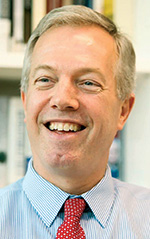Vietnam and the United States: The Way Ahead
A partnership forged from the ashes of war attests to the power of trust and mutual respect.
BY TED OSIUS
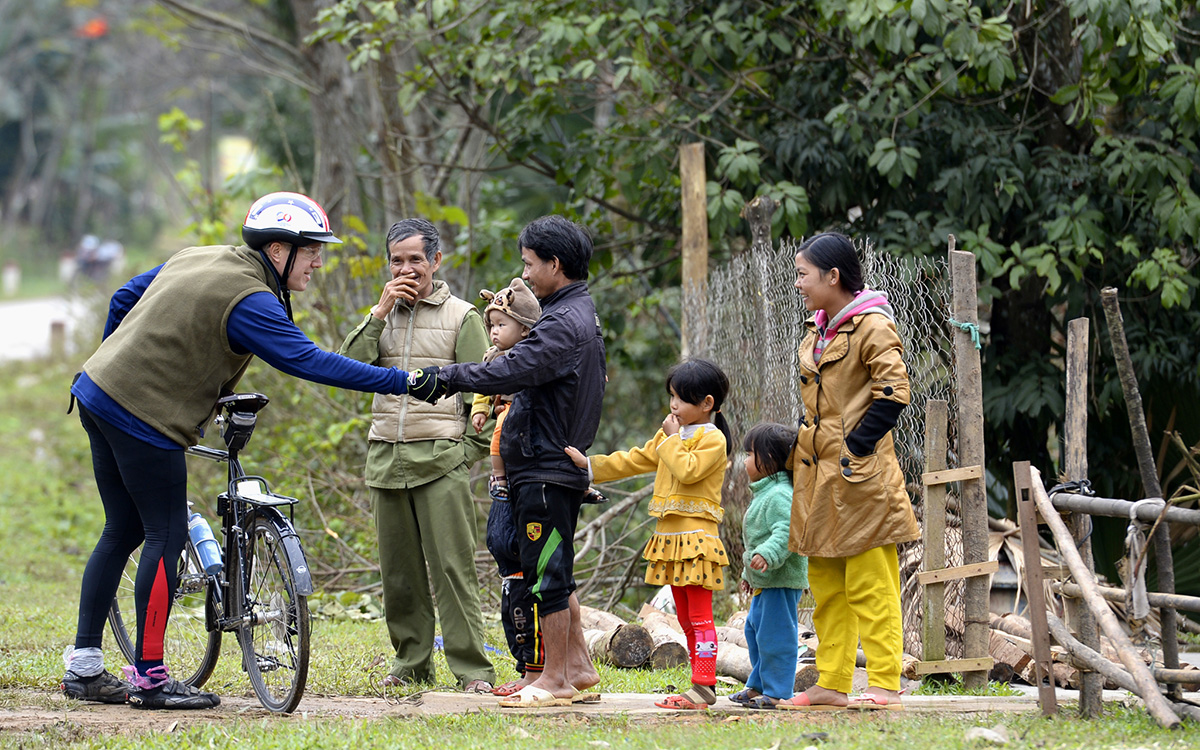
Ambassador Ted Osius meets residents of Nghe An province in March 2016 during a 600-kilometer bike ride from Hanoi to Hue.
Courtesy of Ted Osius
This year the United States and Vietnam are celebrating a vital bilateral relationship forged patiently over the past 30 years from the ashes of war, one now known as a Comprehensive Strategic Partnership. It is a remarkable story of diplomatic accomplishment involving respect, trust, and a joint effort to create a meaningful, powerful partnership. This effort benefits regional and global prosperity, stability, and security.
As America’s eighth ambassador to Hanoi, Marc Knapper, often points out, however, 2025 isn’t only the 30th anniversary of normalized relations and the 50th anniversary of the war’s end, but also the 80th anniversary of Vietnam’s independence. From this perspective, the U.S.-Vietnamese relationship is even more compelling.
Eighty Years Ago
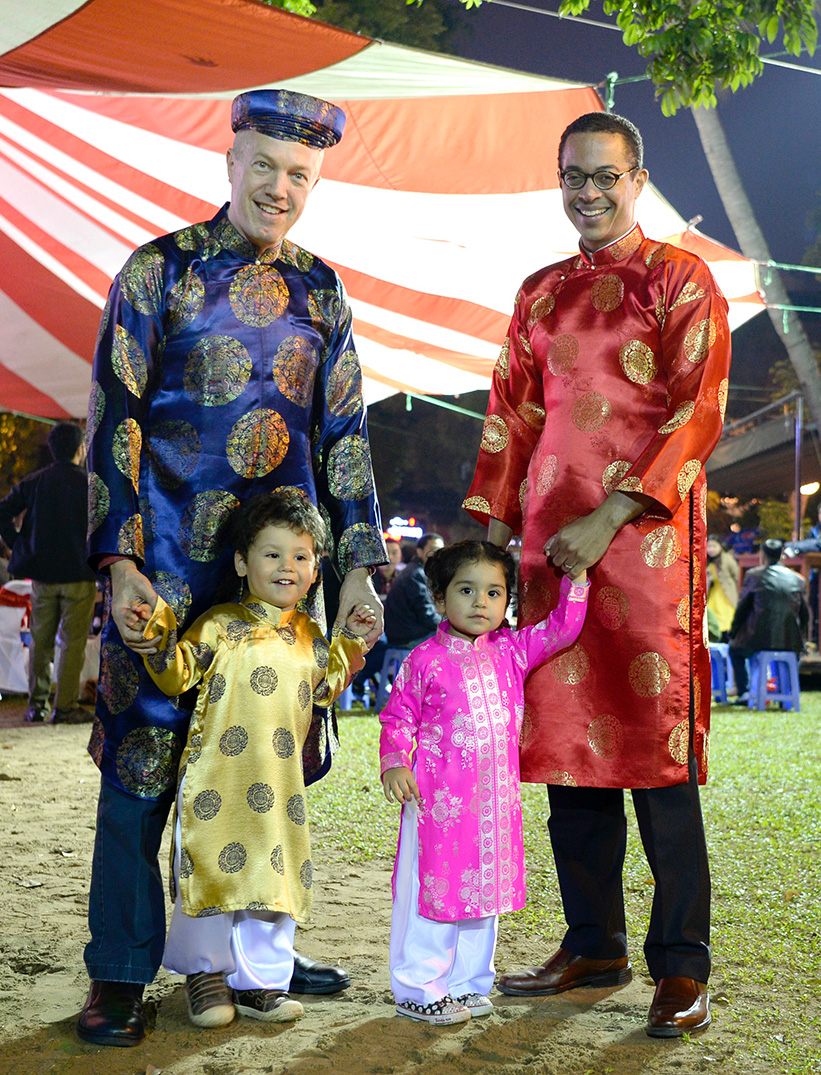
Ambassador Ted Osius and his spouse, Clayton Bond, with their son and daughter wearing traditional Vietnamese clothing to celebrate Tết in Hanoi, February 2017.
Courtesy of Ted Osius
In 1945, as war with Japan was winding down in the Pacific, Americans in the Office of Strategic Services (OSS)—the predecessor of the Central Intelligence Agency—began training an elite force of 200 Việt Minh guerrillas. The OSS’s “Deer Team” knew something about two of the guerrillas, Hồ Chí Minh and his most famous general, Võ Nguyên Giáp. That year, when Henry Prunier of Worcester, Massachusetts, and six other Americans parachuted into Tan Trao village in northern Vietnam on a clandestine mission, Prunier taught the diminutive General Giáp how to throw a grenade.
When I visited Tan Trao in March 2017, as the sixth U.S. ambassador to Hanoi, a guide showed us a massive banyan tree in the clearing at the heart of the Việt Minh’s jungle base. She said one of those long-ago Deer Team agents had parachuted into the tree and gotten tangled in its branches. Armed men emerged from the jungle, and he fired his revolver, thinking they might be some kind of pro-Japanese militia. They retreated, and at daybreak, the OSS agent, still stuck in his harness, woke from a fitful sleep to see a bamboo mat below on which someone had written two words in English: “Welcome friend.”
Relieved, he called out to the Việt Minh, and they cut him down from the tree. Once in camp, he found out that the words that had lured him down had been written by the one person in the guerrilla band who knew some English: their leader and the future president of Vietnam, Hồ Chí Minh.
Hồ, Giáp, and the Việt Minh welcomed the Deer Team. Paul Hoagland, an OSS medic, treated Hồ for malaria and may have saved his life. After grenade lessons, Prunier instructed “Mr. Văn” (aka Giáp) in the use of American rifles, machine guns, bazookas, and other arms. (Prunier earned a bronze star for these exploits and returned to Vietnam in 1995 to meet Giáp, who demonstrated the grenade-lobbing technique Prunier had taught him.)
When Hồ learned that Prunier was from Massachusetts, he told stories of his time as a pastry chef at the Parker House hotel in Boston. Hồ requested a copy of the U.S. Declaration of Independence, which the OSS arranged to be air-dropped into the camp.
In August 1945, after the United States dropped atomic bombs on Hiroshima and Nagasaki, the OSS helped protect Hồ as he traveled to Hanoi to announce Vietnam’s independence. In Hanoi’s Ba Dinh Square, he declared, “All men are born equal: the Creator has given us inviolable rights, life, liberty, and happiness!”
I repeated these words in Vietnamese to the press in Tan Trao, near the spot where Allied planes had dropped the Declaration of Independence for Hồ to study. Hồ had told the United States something important with his use of Thomas Jefferson’s words to announce Vietnam’s independence from France on Sept. 2, 1945, but by then America was too alarmed by encroaching communism in Europe to listen.
The OSS argued against President Harry Truman’s decision to support France in its war against the Vietnamese nationalists. Invoking the “Spirit of 1945”—referring to when the United States had been the prime supporter of Vietnam’s independence—Hồ sent a telegram to President Truman on Feb. 28, 1946: “FRENCH POPULATION AND TROOPS ARE MAKING ACTIVE PREPARATIONS FOR A COUP DE MAIN IN HANOI AND FOR MILITARY AGGRESSION STOP I THEREFORE MOST EARNESTLY APPEAL TO YOU PERSONALLY AND TO THE AMERICAN PEOPLE TO INTERFERE URGENTLY IN SUPPORT OF OUR INDEPENDENCE AND HELP MAKING [sic] THE NEGOTIATIONS MORE IN KEEPING WITH THE PRINCIPLES OF THE ATLANTIC AND SAN FRANCISCO CHARTERS RESPECTFULLY HOCHIMINH.”
Hồ’s message to President Truman did not reach the president and went unanswered. Vietnamese leaders told me that Hồ wrote seven times, but he never received a response.
In 1946, the United States was already obsessed with communism. That obsession had only increased by 1950, when Senator Joseph McCarthy announced that he had a list of supposed Communists working in the State Department. By decimating the team of Foreign Service Asia experts—people who would have known about 11 centuries of enmity between Vietnam and China—McCarthy left the State Department unprepared for the coming conflict in Southeast Asia and contributed to the debacle of America’s engagement in the Vietnam War.
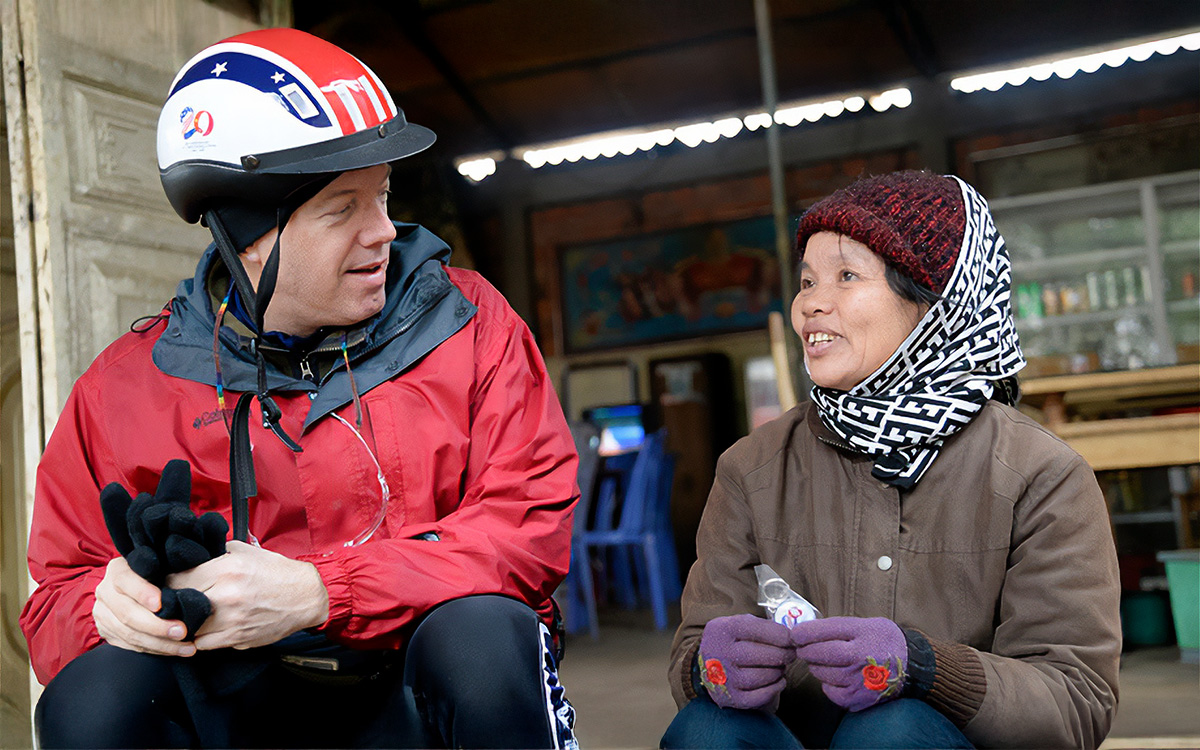
Ambassador Ted Osius chats with a local woman while taking a break during the bike ride from Hanoi to Hue.
Courtesy of Ted Osius
Fifty Years Ago
Graham Martin became ambassador to South Vietnam in June 1973. Accredited to the Republic of Vietnam, that part of the country below the 17th parallel, Martin was chosen for the job of ambassador by Secretary of State Henry Kissinger, who correctly believed that Martin would refuse to depart from Saigon until the bitter end. By March 1975, the North Vietnamese were advancing quickly and overtaking the south.
In April 1975, Saigon was a city under siege, and although Martin had not yet ordered a general evacuation, U.S. Marines began assisting thousands of Vietnamese employees of the U.S. government to leave from Saigon’s Tan Son Nhat Airport in the 12 days before South Vietnam surrendered. Some of these Vietnamese had worked for the U.S. government over the past decade and a half, and they knew that the invading North Vietnamese would treat them brutally as enemies.
Most of the Vietnamese employees were evacuated with their immediate families, flying out on U.S. military transport aircraft and chartered jetliners. Vietnamese personnel working for the Defense Department (nearly all of whom worked for the Central Intelligence Agency) got out on the airlift, as did a number of those employed by the State Department, the U.S. Agency for International Development, and the U.S. Information Agency. Ambassador Martin determined the timing of the evacuations from the country. His decisions to delay evacuations had life-and-death consequences.
On April 25, a 40-man force attached to the Seventh Fleet augmented the small force of beleaguered Marines defending Tan Son Nhat Airport. At 3:45 a.m. on April 29, the North Vietnamese army attacked the airport, and their heavy shelling forced an immediate halt to the evacuation. The first rocket landed on the main road, killing the last two Marines to die in Vietnam, Lance Corporal Darwin L. Judge and Corporal Charles McMahon Jr. In the chaos that ensued, their remains were left behind. At the U.S. embassy, the order for a helicopter evacuation was finally given.
Amb. Martin made the staff wait until the North Vietnamese had already entered Saigon before they could cut down a large tamarind tree on the embassy grounds to make room for helicopters to land. His opposition to giving the general evacuation order until the last moment resulted in many people who worked for U.S. civilian agencies being left behind. The helicopter airlift was too late and too disorganized to rescue many of the locally employed staff who had been told to wait in safe houses for transport to the airport.
Martin contended, against the strong protest of senior U.S. staff at the embassy, that a mass evacuation would have caused panic in South Vietnam’s army and the Marine units defending Saigon, ending hopes for a negotiated cease-fire. By delaying evacuation until the airport in Saigon had been destroyed, Martin failed the Vietnamese who had supported the United States and were left behind.
By decimating the team of Foreign Service Asia experts—people who would have known about 11 centuries of enmity between Vietnam and China—McCarthy left the State Department unprepared.
For 24 hours without a break, Master Gunnery Sergeant John J. Valdez loaded helicopters from the embassy compound. Just before 5 a.m. on April 30, Valdez and Ken Moorefield, a Foreign Service officer and former infantry captain, put Amb. Martin, dazed and suffering from pneumonia, aboard one of the last helicopters to take off from the embassy roof. Moorefield later reported that, as he rode in another helicopter headed for the U.S. fleet, “I realized my war, our war, was finally over.”
When the ambassador departed, the coded message “Tiger is out” was issued, causing confusion among some of the helicopter pilots—who thought the message meant that the evacuation was complete. Still on the embassy roof with the last of his Marines, Valdez noticed that the flow of choppers had decreased: “No birds in sight. But I never thought for one minute that the choppers would leave us behind.” A helicopter returned and lifted the Marines off just before 8 a.m. Valdez was the last Marine to climb aboard. Three hours later, North Vietnamese troops crashed through the gates of Saigon’s presidential palace.
Thirty Years Ago
In early 1995, former Defense Secretary Robert McNamara publicly expressed his shame over the war’s conduct. McNamara said what most Americans already knew: U.S. leaders had let down members of the armed forces when they sent them into battle and had failed the American people by their prosecution of the war. Twenty years after the fall of Saigon, the debates remained personal and painful.
In May 1995, a presidential delegation headed by Deputy Secretary of Veterans Affairs Hershel Gober visited Vietnam and found the government remarkably forthcoming with information about the U.S. servicemen lost during the war. The delegation reported that “more than 800 separate POW/MIA documents have been turned over to U.S. officials by the [Socialist Republic of Vietnam] government.” The success of Gober’s mission allowed President Bill Clinton to argue that genuine collaboration with the Vietnamese was the best way to achieve America’s overriding goal in Vietnam: the fullest possible accounting for Americans missing from the war.
Flanked by almost every Vietnam veteran serving in Congress, as well as Bobby Muller, chairman of the Vietnam Veterans of America, in a wheelchair, President Clinton announced his decision to normalize relations on July 11. Drawing on Abraham Lincoln’s words, the president said: “This moment offers us the opportunity to bind up our own wounds. They have resisted time for too long. We can now move to common ground.” He closed by quoting scripture: “Let this moment ... be a time to heal and a time to build.”
Veterans in Congress supported President Clinton, including Senator Frank Murkowski, the Republican who chaired the Committee on Veterans’ Affairs, and Democrats such as Senators John Kerry, Bob Kerrey, and Bennett Johnston, and Congressman Pete Peterson, who later became the first U.S. ambassador in Hanoi. Most important, Republican Senator John McCain—a Vietnam veteran and former prisoner of war—declared that “tangible progress” had been made toward the fullest possible accounting. “We have looked back in anger at Vietnam for too long,” he added. “I cannot allow whatever resentments I incurred during my time in Vietnam to hold me from doing what is so clearly my duty.”
McCain also pointed out the strategic advantages of a positive relationship with Vietnam. Noting that Vietnam would join the Association of Southeast Asian Nations, McCain wrote: “An economically viable Vietnam, acting in concert with its neighbors, will help the region resist dominance by any one power.”
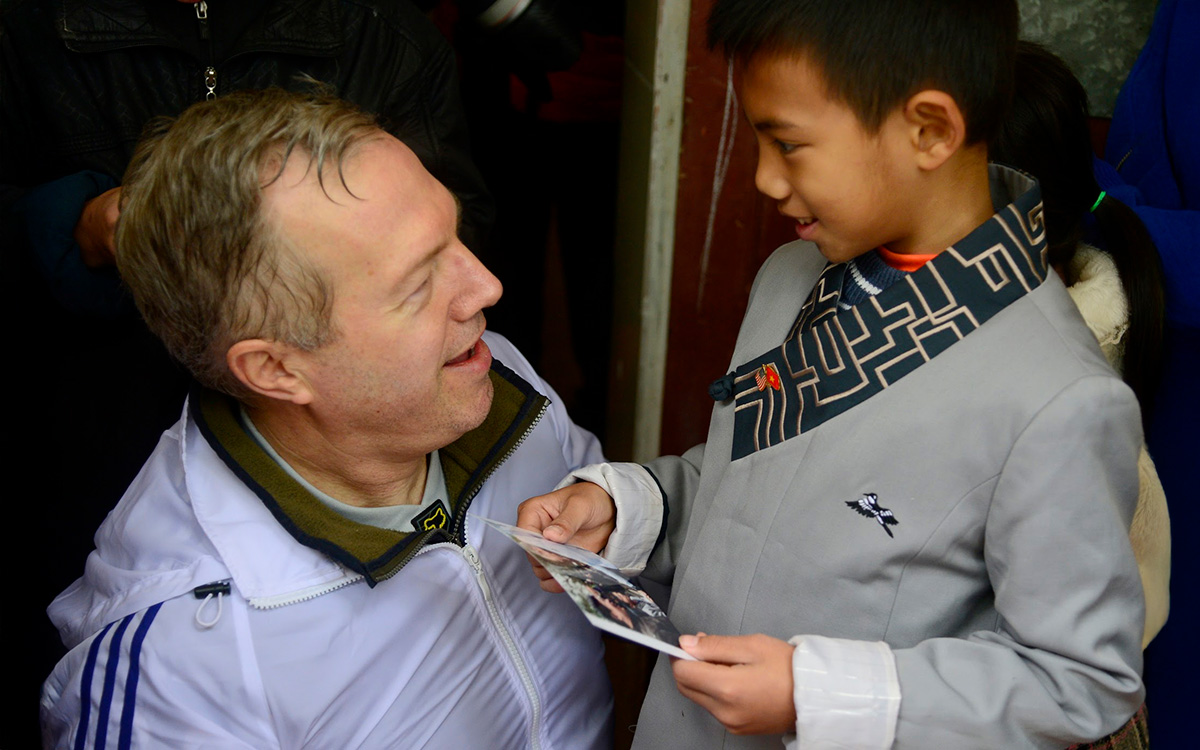
Ambassador Ted Osius meets 8-year-old Phú at an orphanage in Ha Tinh province.
Courtesy of Ted Osius
Forging the New Relationship
In November 2000, Bill Clinton made the first U.S. presidential visit to a united Vietnam. In a speech broadcast live, the president outlined the key elements of a diplomatic agenda he hoped the United States and Vietnam would pursue. Describing Vietnam’s progress from isolation to the political and economic reforms called đổi mới, the president predicted (correctly) that a bilateral trade agreement with the United States would lead to Vietnam’s entry into the World Trade Organization and to the country’s integration into the global economy. Together, he said, Vietnamese and Americans would find and return the remains of soldiers who perished, eliminate land mines and unexploded ordnance, and clean up Agent Orange. For the next 25 years, we pursued that agenda.
My most significant accomplishment as ambassador was to facilitate the visit of Communist Party General Secretary Nguyễn Phú Trọng to the United States in July 2015. In a meeting that broke historic ground, President Barack Obama stated that the United States could respect political systems that differed from our own. He spoke respectfully about how deeply the United States valued human rights, saying, “This is just who we are.” The president and general secretary issued a joint statement after the meeting that included a commitment to “respect ... each other’s political systems”—the most important line in the document for the Vietnamese. The two leaders made other significant commitments, such as continuing party-to-party dialogues, cleaning up dioxin, promoting human rights, supporting educational exchange, and finishing trade negotiations.
In 2016 I had the honor of hosting President Obama in Vietnam. Those three days were, for me, the highlight of a long diplomatic career. The president met with leaders, spoke with young people and entrepreneurs in Ho Chi Minh City, committed to dioxin cleanup—a process that continues to this day—and agreed to open Fulbright University, the only U.S.-style institution of higher education in Vietnam. During Obama’s presidency and the first term of President Donald Trump, the partnership evolved from one focused primarily on addressing the legacies of war to a regional security partnership that also addressed common challenges like climate change, public health, and global peacekeeping.
At the same time, commercial relations between the United States and Vietnam surged. From less than $800 million in 1995, two-way trade ballooned to $138 billion in 2022. The United States is now Vietnam’s largest export market, and Vietnam was our eighth-largest trading partner for the past two years. The year 2023 marked a record high in U.S. investment in Vietnam, with $36 billion in registered investment capital—a 32 percent surge from the previous year. Analysts predict that Vietnam will grow approximately 6.6 percent per year for the next 10 years.
Tens of thousands of Vietnamese study in the United States, contributing nearly $1 billion to the U.S. economy. When they launched a new Comprehensive Strategic Partnership in 2023, President Joe Biden and General Secretary Trọng identified new education initiatives and committed to skills-building in Vietnam. U.S. companies are also investing significantly in workforce development in Vietnam, helping to strengthen the semiconductor ecosystem and boost supply chain resilience. Areas of ongoing collaboration include cybersecurity, undersea cables, and digital infrastructure. This engagement will pay off for both countries and bring us closer together.
As leaders prepare for Vietnam’s 14th Party Congress to chart a course for the future, collaboration with U.S. academics, business leaders, and citizens can help create a legal framework for the digital economy, resolving ethical, legal, and institutional questions surrounding artificial intelligence, and can invest in science, technology, and innovation as critical drivers for economic growth. The United States supports Vietnam’s goals for continued independence, self-reliance, and prosperity and can help provide tools for research, especially in science and technology, biotech, quantum computing, and artificial intelligence.
In New York last September, Vietnam’s new General Secretary Tô Lâm said: “Thirty years ago we could not have envisioned how far we would come.” He added a quote from President Abraham Lincoln: “The best way to predict the future is to create it.”
Former Secretary of State John Kerry, a Vietnam veteran and significant architect of U.S.-Vietnam reconciliation, wrote: “Reconciliation requires hard work, courage, compromise, and—most important—recognition of the humanity of brothers, sisters, friends, and loved ones on both sides. … Step-by-step, Americans and Vietnamese deepened the pool of trust that allowed us to become, if not allies, at least close economic and security partners.”
The story of the United States and Vietnam over the past 30 years is a remarkable testament to the power of trust and mutual respect in bringing together former adversaries and creating a powerful friendship and partnership. The story of the next 30 years promises to be even more exciting.
When sharing or linking to FSJ articles online, which we welcome and encourage, please be sure to cite the magazine (The Foreign Service Journal) and the month and year of publication. Please check the permissions page for further details.
Read More...
- “Respect, Trust and Partnership: Keeping Diplomacy on Course in Troubling Times” by Ted Osius, The Foreign Service Journal, April 2018
- “Nothing is Impossible: America’s Reconciliation with Vietnam” by Ted Osius, book discussion hosted by CSIS Southeast Asia Program, August 2021
- “The Remonstrating Official” by Ted Osius, The Foreign Service Journal, September 2021

